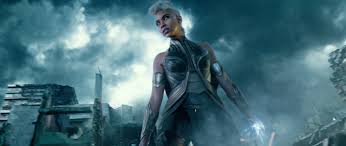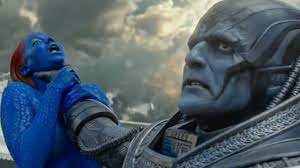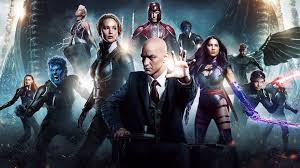X-Men: Apocalypse (2016)

X-Men: Apocalypse (2016) Review
Introduction
Released in 2016, X-Men: Apocalypse is the ninth installment in the X-Men film series. Directed by Bryan Singer, this blockbuster continues the saga of the mutant heroes and introduces one of the most formidable villains in the X-Men universe: Apocalypse. With its grand scale, diverse cast, and high stakes, the movie aimed to be a major milestone in the franchise. But did it live up to the expectations? Let’s dive deep into the film’s plot, characters, and overall execution in this detailed review.
Plot Overview
Set in the 1980s, X-Men: Apocalypse explores the rise of En Sabah Nur, also known as Apocalypse, an ancient and powerful mutant believed to be the first of his kind. After being betrayed and entombed for thousands of years, Apocalypse awakens in a world he deems unworthy. He begins recruiting powerful mutants to serve as his Four Horsemen and plans to cleanse the world of humanity, reshaping it to fit his vision.
The X-Men, led by Charles Xavier (James McAvoy) and Raven/Mystique (Jennifer Lawrence), must band together to stop this existential threat. Meanwhile, the film delves into the backstories of iconic characters like Magneto (Michael Fassbender), Jean Grey (Sophie Turner), and Cyclops (Tye Sheridan), providing emotional depth amidst the action.
Strengths
1. The Cinematic Scale
One of the standout aspects of X-Men: Apocalypse is its ambitious scale. The movie features sprawling action sequences, global stakes, and impressive special effects. The final battle in Cairo is a visual spectacle, showcasing the destructive power of Apocalypse and the resilience of the X-Men.
2. Ensemble Cast
The film boasts an ensemble cast that brings both new and familiar faces to the forefront. James McAvoy’s portrayal of Professor Xavier continues to be a highlight, balancing wisdom and vulnerability. Michael Fassbender’s Magneto gets a poignant arc, exploring his grief and struggle to find peace.
Sophie Turner’s debut as Jean Grey adds a fresh perspective to the team, while Evan Peters’ Quicksilver once again steals the show with his humorous and visually stunning slow-motion sequence.
3. Introduction of Apocalypse
Oscar Isaac’s transformation into Apocalypse is visually striking. The character’s godlike presence and chilling philosophy about survival of the fittest make him a compelling antagonist. His interactions with other mutants, particularly Magneto, create moments of tension and intrigue.
Weaknesses
1. Underwhelming Villain Execution
While Apocalypse is a significant figure in the comics, his portrayal in the film feels somewhat one-dimensional. Despite Oscar Isaac’s best efforts, the character lacks the complexity and depth that made villains like Magneto or William Stryker memorable in previous films.
2. Pacing Issues
At over two hours, the movie’s pacing can feel uneven. The first act spends considerable time setting up the story, while the second half accelerates rapidly, sometimes at the expense of character development.
3. Character Overload
With so many characters to juggle, some fan-favorites receive limited screen time. Storm (Alexandra Shipp), Psylocke (Olivia Munn), and Angel (Ben Hardy) serve primarily as Apocalypse’s henchmen, with little exploration of their motivations or personalities.
Themes and Symbolism
1. Power and Responsibility
A recurring theme in X-Men films, the idea of wielding great power responsibly is central to this movie. Apocalypse’s god complex contrasts sharply with Xavier’s philosophy of coexistence, creating a moral dilemma that resonates throughout the film.
2. Grief and Redemption
Magneto’s arc is particularly poignant. His attempt to live a peaceful life is shattered, leading him to embrace Apocalypse’s ideology. However, his ultimate redemption highlights the enduring struggle between vengeance and hope.
3. Unity Amidst Diversity
The X-Men’s diverse team embodies the idea of strength through unity. Despite their differences, they come together to protect a world that often fears and misunderstands them.
Visual and Technical Aspects
1. Special Effects
The movie’s visual effects are undeniably impressive. From Apocalypse’s transformative abilities to Quicksilver’s time-bending antics, the film delivers on the visual front. The destruction of cities and battle sequences are rendered with meticulous detail.
2. Costume Design
The 1980s-inspired costumes add a nostalgic touch while staying true to the characters’ comic book origins. Psylocke’s costume, in particular, stands out for its faithful adaptation.
3. Score and Sound Design
John Ottman’s score complements the movie’s epic tone, enhancing both emotional and action-packed moments. The sound design, especially during Apocalypse’s power demonstrations, amplifies his menacing presence.
Comparison to Other X-Men Films
When compared to its predecessors, X-Men: Apocalypse has its highs and lows. It doesn’t quite reach the emotional depth of X-Men: First Class (2011) or the narrative complexity of X-Men: Days of Future Past (2014). However, it expands the franchise’s mythos and sets the stage for future installments.
The movie also marks a transition for the series, introducing younger versions of classic characters like Cyclops, Jean Grey, and Nightcrawler (Kodi Smit-McPhee), paving the way for a new generation of X-Men stories.
Final Verdict
X-Men: Apocalypse is an ambitious entry in the X-Men franchise that offers plenty of action, impressive visuals, and a solid ensemble cast. However, it falls short in delivering a truly compelling villain and struggles with pacing and character development. While it may not be the strongest film in the series, it remains an entertaining watch for fans of the franchise and sets the stage for exciting developments in the mutant saga.
Rating: 7/10